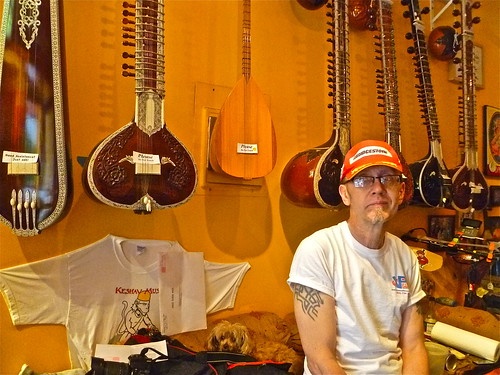For every East Village business that’s opening or closing, dozens are quietly making it. Here’s one of them: Keshav Music Imports.
During his forty-six years as a professional musician, Keshav Hunter (known to most as Keshav Das) has played with the likes of Sting, Jeff Buckley, and Alice Coltrane. He also spent twelve years touring with Krishna Das and playing with him at the Jivamukti Yoga School. “Everywhere we went people would say, ‘Hey man, where can we get a harmonium?'”, said the 59-year-old. Finally, he decided to open a store where fellow musicians could shop for Indian instruments or just sit around and play them while sipping chai and smoking beedies. Nearly eight years after Keshav Music Imports moved from its namesake’s Suffolk Street apartment to a 300-square-foot space at 67 East Fourth Street, between Second Avenue and Bowery, the owner is still plucking away at sitars as well as selling and repairing them. We asked him how he’s managed to make it.
Your store seems to be doing well. Why do you think that is?
Musicians and artists are always looking for a new flavor. People in general are looking to fill a hole. Some people fill it with music. Some people fill it being on the Internet. Some people fill it with sex, some with drugs. I fill it with music and find people with the same thinking.
How much foot traffic do you get in this little shop?
I’m 50 percent Internet and 50 percent in-store. Initially I was straight Internet. I was working out of my apartment first but I got popular because people were hearing about me through word of mouth. They were tired of buying junk and they were hearing that I wasn’t selling junk.
How do you make sure you don’t get junk?
I get my instruments from places all over India and I know India well after touring and living there for ten years and doing business in India for so long. I specialize in working with the new talent in India. The Indian classical music community is so tight and incestuous. If one guy buys a sitar from some guy in Calcutta, everyone will go to him only until the quality goes down and the prices go up. I saw this and decided instead to work with the small, no-name guys who make high quality stuff but don’t get any face time because they aren’t online or Internet savvy. These are the goes that don’t have a publicist, but then I also make it a policy to pay them fair and well. People know me there. It’s now more people finding me than me having to find people. Also, I take a lot of risk.
What kind of risk?
I have guys who I don’t really know, maybe just vaguely heard of and I’ll risk it and put in an order of $1,000 worth of stuff from them. Sometimes it works out and sometimes it does not. It’s a risk because it’s the nature of doing business with Indian music store people. 99 percent of them don’t care if you don’t come back. Their attitude is: “I get your money and I don’t care if you come back because we have 35 billion people in India. If you don’t come back, some other sucker will come.” Short sightedness is something they’re famous for.
What can $1,000 get you in India?
Seven pairs of tablas, or two really good sitars. Two harmoniums
Instrument repair is another revenue stream you decided to provide?
I repair because I had to. I had to really understand these instruments and what they were made of. Not enough people knew how to fix them, so it was out of necessity. I had to learn fast because other wise my reputation would be dead. This is a fast business; you have to prove yourself immediately.
Do you sell any music?
Unfortunately, no. The Internet and MP3s killed the CD business. I used to have the biggest collection of Indian classical music in New York. I used to have over 1,000 titles, but there is no point because everyone uploads it for free now.
What’s the coolest thing in here?
I have a 45-year-old Hiren Roy sitar. I’m selling that for $2,500; it was made by the real Hiren Roy himself. The real deal is hard to get because now they’re made by his cousin, or, his cousin’s uncles cousin. When you find a real one and a vintage one like this, it’s a real treat.
How much has your rent gone up since you moved in here eight years ago?
When I came in here I was paying $1,400 thanks to the co-op protecting the prices. Now my rent is under $2,000 and it’s manageable. This block is special because they only have little merchants. You won’t ever see big box stores like 7-Eleven and Starbucks here.
Do you plan on staying?
My plan is to stay, but maybe I’d go even smaller.
Smaller than 300 square feet?
Well there is so much overhead to operate this place. I pay so much for insurance and trash removal, and it’s all gotten worse because of the economy. From the time I started the business in 1994 to 2008, I was making about 20 percent more a year. But when 2008 hit it went flat. I haven’t made that kind of money since. I make enough to stay but it’s difficult. The other guys who are out there are basically out of business or just barely hanging on.




